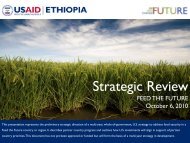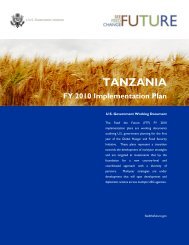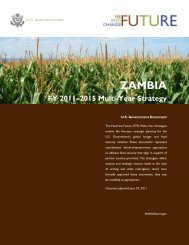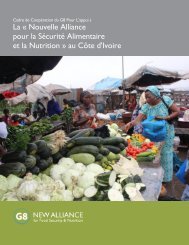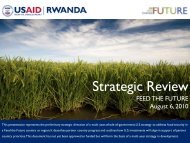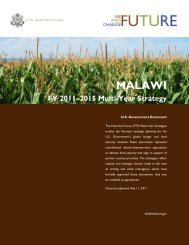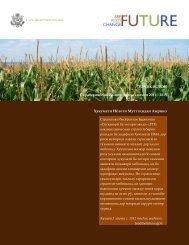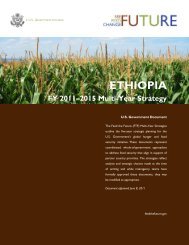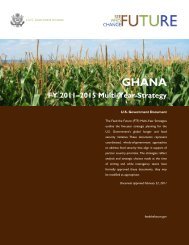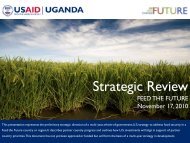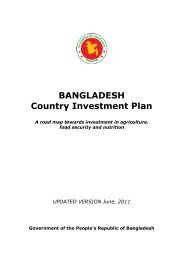Feed the Future Multi-Year Strategy, Senegal, Public
Feed the Future Multi-Year Strategy, Senegal, Public
Feed the Future Multi-Year Strategy, Senegal, Public
You also want an ePaper? Increase the reach of your titles
YUMPU automatically turns print PDFs into web optimized ePapers that Google loves.
1. INTRODUCTION<br />
“Hunger robs <strong>the</strong> poor of a healthy and productive life and stunts <strong>the</strong> mental and physical development<br />
of <strong>the</strong> next generation. Undernutrition costs developing countries up to 3 percent of <strong>the</strong>ir annual gross<br />
domestic product and places individuals at risk of losing more than 10 percent of <strong>the</strong>ir lifetime earning<br />
potential. Reducing chronic hunger is essential to building a foundation for development investments in<br />
health, education, and economic growth.” -The Global Commitment to <strong>Feed</strong> <strong>the</strong> <strong>Future</strong><br />
USAID/<strong>Senegal</strong>, with <strong>the</strong> help of both internal and external partners and in response to<br />
USAID/Washington guidelines, revisited <strong>the</strong> Mission’s FY 2010 Global Hunger and Food Security<br />
Initiative Plan in order to leverage strengths and successes into a whole-of-U.S. Government five-year<br />
<strong>Feed</strong> <strong>the</strong> <strong>Future</strong> <strong>Strategy</strong>. The strategy is tied closely to <strong>the</strong> Government of <strong>Senegal</strong>’s Country<br />
Investment Plan (CIP), and assessed USAID/<strong>Senegal</strong>’s unique comparative advantage vis-à-vis o<strong>the</strong>r<br />
donors and institutions. The <strong>Feed</strong> <strong>the</strong> <strong>Future</strong> <strong>Strategy</strong>, reflecting <strong>Senegal</strong>’s whole-of-U.S. Government<br />
(USG) response to food security, poverty and nutrition challenges, was presented in Washington D.C.<br />
during October 2010.<br />
2. DEVELOPMENT CHALLENGES AND OPPORTUNITIES<br />
2.1 DEVELOPMENT CHALLENGES<br />
<strong>Feed</strong> <strong>the</strong> <strong>Future</strong> priorities are solidly grounded on Millennium Development Goal (MDG) 1 and in line<br />
with <strong>the</strong> international consensus that poverty is not only measured by income levels, but also by<br />
nutritional status.<br />
Many analyses of <strong>Senegal</strong>’s food security, nutrition, and economic development challenges and<br />
opportunities were, and continue to be, discussed in consultation with in-house and external specialists<br />
and development partners. USAID/<strong>Senegal</strong> will lead <strong>the</strong> USG focus on <strong>the</strong> following five areas in<br />
concert with <strong>the</strong> Government of <strong>Senegal</strong> (GOS) and donor partners in order to increase incomes and<br />
improve nutritional status:<br />
1. Agriculture driven economic growth - productivity increases through a value chain approach and<br />
promotion of sound land management<br />
2. Household behaviors that promote optimal nutrition<br />
3. Enhanced policy implementation<br />
4. Streng<strong>the</strong>ned rural infrastructure and access to finance<br />
5. Increased human resource capacity, both at health facilities and every level of <strong>the</strong> agricultural<br />
sector including associated institutions<br />
Many of <strong>Senegal</strong>’s challenges arose in <strong>the</strong> absence of a long-term vision for agricultural development,<br />
which resulted in a lack of infrastructure, limited operational strategy and implementation, longstanding<br />
under-investment, and limited political will to undertake policy reform or improve <strong>the</strong> operating<br />
environment. However, <strong>the</strong> Government of <strong>Senegal</strong>’s growing investment in agriculture (of over 10<br />
percent per year) opened <strong>the</strong> door for progress in <strong>the</strong> food economy. Moreover, <strong>Senegal</strong>’s final CIP,<br />
<strong>the</strong> coordination of which is housed in <strong>the</strong> Office of <strong>the</strong> Prime Minister, fur<strong>the</strong>r emphasizes <strong>the</strong> desire to<br />
elevate agriculture as <strong>the</strong> primary driver for economic growth. The CIP focuses heavily on increasing<br />
<strong>the</strong> production of rice, maize, and millet as well as preserving fishery resources. Preliminary estimates<br />
5



